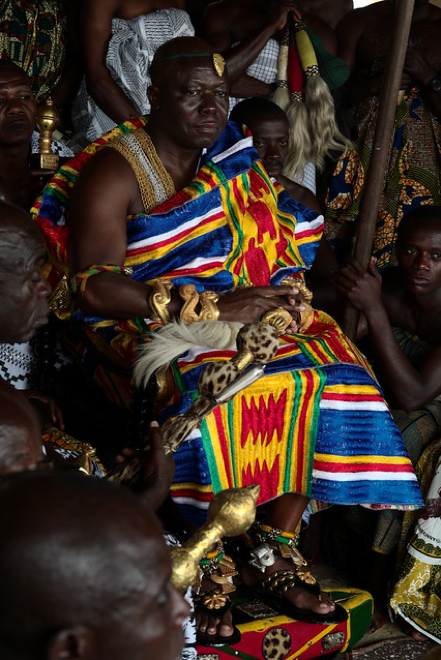Once upon a time, in the 18th century, in a part of present-day Ghana on the coveted Gold Coast, was the Ashanti kingdom. It was the fruit of the unification of the Akan states by King Osei Tutu. The Ashanti, a warlike people, developed a complex and refined culture in which gold metalwork and woodcarving was central. – Pauline Lalondrelle et Lara Maye
The wars between the people of this region took a different turn with the arrival of Europeans attracted by the wealth of what they called the Gold Coast. Legend tells that a golden stool was brought down from the sky by the great priest Okomfo Anokye to assert the authority of the king and the unity of the kingdom. It was said to contain the spirit of the Akan people.[1]
This object of power was visible only to the king and the high priest. The British made a quest to find the stool in the belief that it could help them gain authority in the region. This led to a war called the War of the Golden Stool in 1900. The conflict ended with the British annexation of Ashanti territory, but Ashanti rage was such that the golden stool remained untouched by the British.[2]

An undervalued Heritage?
Disciplined and sophisticated, the Ashanti developed a refined court culture in which the golden stool has a symbolic place; it is at the center of the kingdom’s flag. This traditional culture seems alive.[3] The current king is also
called Osei Tutu II and his mission is to strengthen the identity and cohesion of his people in the Republic of Ghana.[4] It represents a living heritage of great value. Ashanti architecture is recognized by the UNESCO and its art is renowned and imitated in the world. These tangible and intangible resources are very promising for the development of tourism in the country but is little valued at present.[5]

Pauline Lalondrelle et Lara Maye
[1] Doran, R. Akan Leadership arts, Formerly Fowler Museum, UCLA.
[2] Pescheux, G. (2003). Le royaume asante (Ghana) : Parenté, pouvoir, histoire, XVIIe-XXe siècles (Hommes et sociétés). Paris: Ed. Karthala.
[1] Müller, L. (2013). Religion and chieftaincy in Ghana : An explanation of the persistence of a traditional political institution in West Africa (Anthropology of religion = Religionsethnologie 2). Zürich: Lit.
[2] Adjibi Nourou, M. (1 Avril 2019) Ghana: le roi ashanti Osei Tutu II lance un fonds de développement de plus de 100 millions $, Agence ecofin,
[3] Huet, J.- C. (2001) Le Ghana, royaume de l’or. Clio 2012.
References:
Doran, R. (2018) Akan Leadership arts, Formerly Fowler Museum, UCLA. Available at : https://africa.uima.uiowa.edu/topic-essays/show/8?start=7 (accessed: 25 May 2019).
Huet, J.- C. (2001) Le Ghana, royaume de l’or. Clio 2012.
Adjibi Nourou, M. (2019, 01 avril) Ghana: le roi ashanti Osei Tutu II lance un fonds de développement de plus de 100 millions $, Agence ecofin,
Available at : https://www.agenceecofin.com/economie/0104-65082-ghana-le-roi-ashanti-osei-tutu-ii-lance-un-fonds-de-developpement-de-plus-de-100-millions (accessed: 13 May 2019).
Müller, L. (2013). Religion and chieftaincy in Ghana : An explanation of the persistence of a traditional political institution in West Africa (Anthropology of religion = Religionsethnologie 2). Zürich: Lit.
Pescheux, G. (2003). Le royaume asante (Ghana) : Parenté, pouvoir, histoire, XVIIe-XXe siècles (Hommes et sociétés). Paris: Ed. Karthala.
